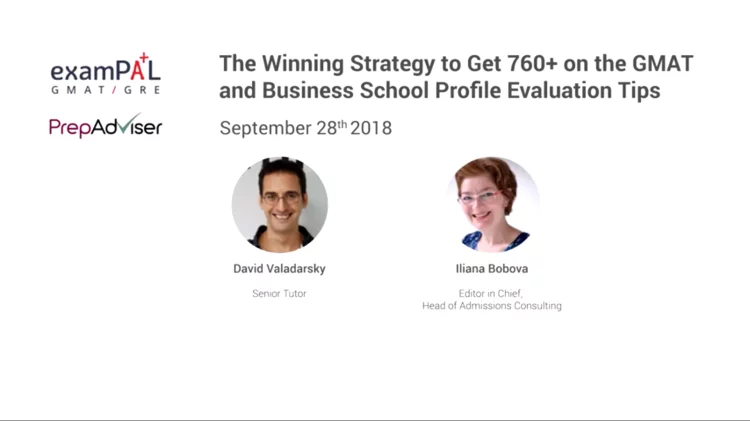This is a recording of the free online webinar which was hosted by PrepAdviser and ExamPal on September 28th, 2018. It focused on business school profile evaluation tips from PrepAdviser’s Editor in Chief, Head of Admissions Consulting, Iliana Bobova and strategies for a 760+ score on the GMAT from Senior Tutor at ExamPal David Valadarsky.
How is my MBA profile evaluated?
- Your profile is evaluated at two stages. The first one is before you even apply to a business school. At this stage, you should be building your initial application strategy. Having your profile evaluated early on, will help you find out whether it is the right time in your career to be applying to a business program.
How can I start the process?
- One method is by using some automatic online profile evaluation tools on different websites. PrepAdviser has different options for that. These tools can be helpful to generate a general idea what caliber of schools you are eligible for, acting as a general guideline.
- Another option, is to have an admissions expert or coach evaluate your profile. First, there is the benefit of interaction—whether face to face or online. The value is that you can ask questions directly and receive answers that will give you a clear understanding of where you stand in the applicant pool. Some advice you would receive is what schools you should target, and areas of improvement that you can work on for a strong application.
- The third way you can have your profile evaluate before applying, is contacting business school admissions officers. They will be glad to give you feedback on how well your profile fits their program. You can contact them by filling out a form on their website, or sending them an updated CV. You can also meet them face to face at networking events, webinars, or at one-to-one meetings hosted by Access MBA.
What is the second stage of a profile evaluation?
- The second stage at which your profile is evaluated is during your application to business schools. It’s important to realize that the admissions committee of the university is made up of several individuals. Each one will offer a unique perspective, as they look for different information in your application. Members of the committee usually include the admissions director, admissions officer, program director, currents students or alumni, and the career center director. Iliana reminds candidates to add as much data and factual evidence to support their application. She adds:
I have seen in my practice, a number of cases where applicants either didn’t choose the school to be adequate to their career goals, or in the form they failed to express their career goals and how the program will help meet them.
What are the building blocks of a business school profile?
- As with any postgraduate degree, an MBA requires academic qualifications – at minimum, a Bachelor’s degree. Next, business schools prefer to set requirements in professional work experience instead of posing strict age limitations. An example might be 2-5 years of full-time, relevant work experience, with a minimum of 1 year at a managerial role. The third block that makes a business profile is the aptitude. This includes your GPA, language skills (TOEFL/IELTS), subject matter skills (GMAT/GRE), quality of work experience, and academic and professional interests.
What is the process of a profile evaluation?
- It can be broken down into three factors: eligibility, potential for success, and the X factors. At the initial stage, business schools will filter out candidates based on their academic qualifications, work experience and age range. Then, they will consider your potential for success by reviewing your language and aptitude skills. The last step, and probably the most crucial, is what makes you unique. These X factors include your potential contribution to the cohort and growth in the program, as well as the relevancy of your career plan.
How do I get a 760+ on the GMAT?
- First, you need to realize that the GMAT is not about knowledge or being smart, but rather on developing the right set of skills and learning how to apply them on the exam.
- There are three elements for achieving a high GMAT score: cognitive flexibility and rapid improvement, complemented by a winning study plan.
- Contrary to popular belief, excessive practice will not lead you to a high score. David explains:
What you really need to do, is understand what the best methods to solve each question are, and which ones work especially best for you. This boils down to timing. The hardest part of the GMAT is not the material—which is more or less high-school level…but it’s difficult because you don’t have time. You have around 2 minutes per question in the quant section, and a bit less in the verbal section. This is why you need cognitive flexibility.
- Cognitive flexibility is the ability to quickly find the fastest way to solve each question and apply it. ExamPal tutors offer a few ways to achieve this by using the PALgorithm approach. P— Precise: Arriving at an exact answer using high-school methods (for example taking a linear equation and finding the root of it using various equations); A—Alternative tools that will get us the right answer, even if we’re unsure why the answer is correct (i.e. process of elimination); L— Logical, basic properties or symmetries without long calculations to reach an answer ( i.e. the sum of any even numbers will always be even).
To find out more about the remaining two elements of how to get a 760+ on the GMAT, and practice some questions with David, watch the entire webinar recording. For timing tips on the Verbal Section, read Solving SC Questions on the GMAT with Speed (Video).



